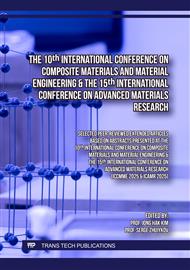p.3
p.9
p.15
p.21
p.27
p.33
p.41
p.49
Tensile Property Enhancement by Laying the Continuous Carbon Fiber during 3D Printing Process
Abstract:
Fused Deposition Modeling (FDM) is widely used in additive manufacturing. The main limitations of 3-Dimentisonal (3D) printing are the expansive cost of the material and its low strength as compared to the traditional molding process. The supported material was more expensive because of the extrusion process. The high surface roughness in the nature of 3D printed objects is the principal reason for mechanical property weakness. To eliminate such problems, a pellet-based 3D printer coupled with the layup fiber technique was introduced in this preliminary study. The obtained result indicated that the sample produced by the pellet-based printer had the highest mechanical strength in the machine direction. A reduction in tensile strength was found at another raster angle. After considering the differences between carbon fiber (CF) formats, it was found that chopped fiber was ineffective in terms of printed strength. At the same time, the layup fabric type and continuous fiber could promote better mechanical properties. When analyzing the ratio of maximum strength/fiber weight, it should be noted that continuous fiber presented the highest reinforced efficiency.
Info:
Periodical:
Pages:
21-26
Citation:
Online since:
June 2025
Price:
Сopyright:
© 2025 Trans Tech Publications Ltd. All Rights Reserved
Share:
Citation:



